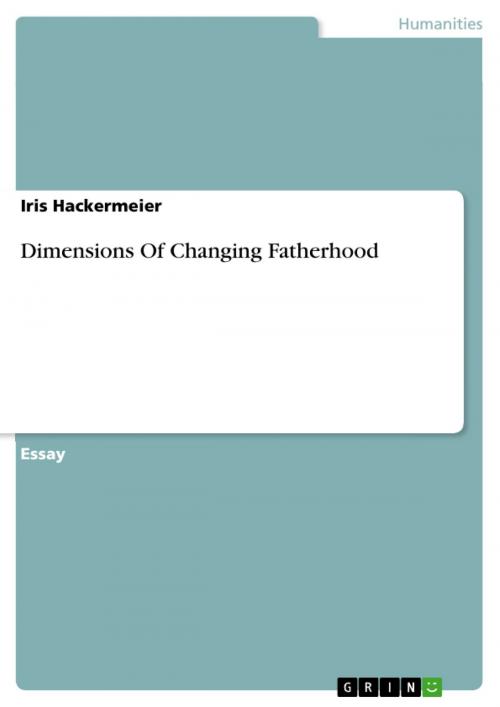| Author: | Iris Hackermeier | ISBN: | 9783638538268 |
| Publisher: | GRIN Publishing | Publication: | August 25, 2006 |
| Imprint: | GRIN Publishing | Language: | English |
| Author: | Iris Hackermeier |
| ISBN: | 9783638538268 |
| Publisher: | GRIN Publishing |
| Publication: | August 25, 2006 |
| Imprint: | GRIN Publishing |
| Language: | English |
Essay from the year 2006 in the subject Sociology - Gender Studies, grade: B, LMU Munich (Psychology of Excellence), course: Family and Kinship Systems, 15 entries in the bibliography, language: English, abstract: A father is traditionally the male parent of a child, says the recent documentation in the British encyclopedia Wikipedia (2006). Fathers may be, like mothers, categorized regarding their biological, social or legal relationship with the child. Historically it is meant that the biological relationship paternity has been determinative of fatherhood. However, proof of paternity has been intrinsically problematic and so social rules often determine who would be considered as the father, for instance the husband of the mother. This method of the determination of fatherhood has lived on since Roman times. The historical approach has been destabilized with the recent emergence of accurate scientific testing, particularly DNA testing. As a result, the law on fatherhood is undergoing rapid changes (Wikipedia, 2006). Kost (2001) argues, that fatherhood is just a role that is socially constructed. Consequently these 'agreed upon meanings' can change over time and individual behaviors as well as routines associated with the role would adapt in response to different meanings. Likewise the function or purpose of a role, in this case of the 'father', can also change over time. For while a man may be a father, his paternal conduct provides insight into the meaning that he attaches to that role. To be able to project the future of fatherhood, we need to understand the past and present patterns of family life. Here we also need to observe the linkages between different styles of fatherhood and the various social, economic, and demographic conditions. This is especially important within the context of race, ethnicity, and class differences in parenting (Tanfer and Mott, 1997). On the following pages, I will focus on the influencing factors of changing fatherhood. Only by viewing those different perspectives, we will understand the metamorphosis of fathering. The current literature review shows, that historical development and cultural differences play an important and dominant role. Although biological influences as well as resulting personality traits might have prejudiced fathering since beginning of mankind. All three dimensions play an important role and cannot be seen separated, without another. This is, why I will introduce the three factors by mainly describing one by one, although the other two dimensions will be present, too.
Essay from the year 2006 in the subject Sociology - Gender Studies, grade: B, LMU Munich (Psychology of Excellence), course: Family and Kinship Systems, 15 entries in the bibliography, language: English, abstract: A father is traditionally the male parent of a child, says the recent documentation in the British encyclopedia Wikipedia (2006). Fathers may be, like mothers, categorized regarding their biological, social or legal relationship with the child. Historically it is meant that the biological relationship paternity has been determinative of fatherhood. However, proof of paternity has been intrinsically problematic and so social rules often determine who would be considered as the father, for instance the husband of the mother. This method of the determination of fatherhood has lived on since Roman times. The historical approach has been destabilized with the recent emergence of accurate scientific testing, particularly DNA testing. As a result, the law on fatherhood is undergoing rapid changes (Wikipedia, 2006). Kost (2001) argues, that fatherhood is just a role that is socially constructed. Consequently these 'agreed upon meanings' can change over time and individual behaviors as well as routines associated with the role would adapt in response to different meanings. Likewise the function or purpose of a role, in this case of the 'father', can also change over time. For while a man may be a father, his paternal conduct provides insight into the meaning that he attaches to that role. To be able to project the future of fatherhood, we need to understand the past and present patterns of family life. Here we also need to observe the linkages between different styles of fatherhood and the various social, economic, and demographic conditions. This is especially important within the context of race, ethnicity, and class differences in parenting (Tanfer and Mott, 1997). On the following pages, I will focus on the influencing factors of changing fatherhood. Only by viewing those different perspectives, we will understand the metamorphosis of fathering. The current literature review shows, that historical development and cultural differences play an important and dominant role. Although biological influences as well as resulting personality traits might have prejudiced fathering since beginning of mankind. All three dimensions play an important role and cannot be seen separated, without another. This is, why I will introduce the three factors by mainly describing one by one, although the other two dimensions will be present, too.















